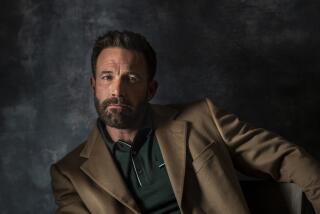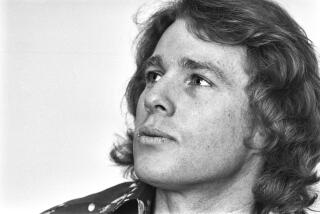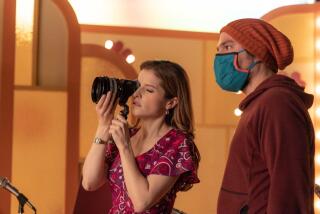Film Pioneer Recalls Roles From Keystone Kops to ‘Gone With Wind’
Frank Fawcett has been hit in the noggin with more cream pies than he cares to remember.
He has been in countless zany car chases, roaring up and down the streets of downtown Los Angeles in a battered jalopy, dicing with trolleys and pedestrians alike. He has teetered at the edge of sheer cliffs. He has even suffered the celluloid indignity of having his car chopped in half by a hurtling freight train.
For Fawcett, it was all part of the job description. The 90-year-old Leucadia resident once served on Hollywood’s most madcap police force, those harebrained gendarmes of the silent-screen era, the Keystone Kops.
As a strapping young man in the 1920s, Fawcett appeared in more than 50 uproarious episodes of the Keystone Kops, working both in front of and behind the camera--as actor, assistant director, stunt man, makeup artist. Today, Fawcett is one of the last survivors of the troops of actors who comprised the Kops.
While these form the core of Fawcett’s memories of Hollywood’s Golden Era, those slapstick side-splitters are only a fraction of the flicks he appeared in or worked on during two decades in the film industry. Fawcett estimates he had roles in more than 400 films during the 1920s and 1930s.
Many of them were low-budget pictures shot in less than a day, but others are among the undisputed classics of the period: “Wings” (which captured the first Oscar ever awarded by the motion picture guild and featured Fawcett as a German flying ace), “The Sea Hawk,” “Robin Hood,” “The Thief of Baghdad,” “Daddy Long Legs” and “Gone With the Wind” (Fawcett played a soldier gunned down by Scarlett O’Hara).
“I never played the great big parts,” recalled Fawcett, who has also appeared in Shakespeare on the stage and sung opera. “I’m a spot man. My kind of glory was as assistant director. You would act, move sets, do just about everything.”
Acting, he says, always seemed to be his birthright. Indeed, Fawcett contends he was literally brought into the world on the stage.
According to Fawcett, his mother went into labor while appearing at a playhouse in Indianapolis in 1896. After the third act, she went off into the wings and bore baby Frank.
“She wiped me off,” Fawcett says, recalling the story with glee. “They put feathers on me and brought me out to the applause of the crowd. It was my first appearance on stage.”
After serving in World War I, Fawcett came west to Los Angeles, where an uncle ran a feed yard. But instead of working in the yard, Frank became a protege to another uncle who was a production assistant for D.W. Griffith, the leading director of the silent-film era.
Fawcett says he was quickly tabbed for a bit role in “Daddy Long Legs” by the star, Mary Pickford.
It was the beginning of a long career. Over the years that followed, Fawcett worked with Griffith, with Charlie Chaplin, with Douglas Fairbanks--and with the Keystone Kops.
Through the Depression, Fawcett continued to act, first with a government-sponsored theater troupe and later a subsidized motion picture project. In the late 1930s, he managed several theaters.
When World War II broke out, Fawcett left Hollywood to work at the docks of San Pedro as an electrician outfitting P.T. boats and mine sweepers. At the conclusion of the war, Fawcett said, he sought to return to the motion picture business, but the Screen Actors Guild wanted dues for the five years he had been idled by the war.
Irritated by the thought of his paycheck being cut in half to pay the dues, Fawcett decided to quit the Big Screen forever. He became an electrician for the Broadway department stores and, after 20 years with the company, retired to Leucadia with his wife, Mary, in 1965.
Though never a star of any renown in the Hollywood firmament, Fawcett nonetheless exudes a theatrical persona to this day. He typically greets visitors to his comfortable coastal home while wearing a stylish black beret, khaki shirt and pants, a dramatic red scarf draped around his neck.
A billowing gray beard frames his face. The ends of his mustache are twirled outward into spikes, like some modern-day musketeer. His blue eyes seem small, but they twinkle with mischief as Fawcett describes, as if it were yesterday, a screwball sequence from a movie shot more than 50 years ago.
The voice is a bit gravelly, and Fawcett admits he doesn’t get around quite as well as he did in his days in front of the footlights. Fawcett’s wife died about two years ago. His eyesight has grown too poor for him to drive a car, so Fawcett trundles around the neighborhood in an electric-powered cart he recently purchased (“Goes up to 20 m.p.h.,” he boasts).
Fawcett’s physique, once the barrel-chested sort of build that could make a starlet swoon, has thinned out a bit with the years. But the old lion still has some roar: He shakes a visitor’s hand with a crushing grip that belies his age.
His house is like a museum of old-time Hollywood. On the white picket fence that lines the front yard, a wooden sign is routed with the words: “Keystone Cop, Retired.” It was a gift from a neighborhood youth whom Fawcett would entertain with stories of his past.
Out back, a latticed greenhouse holds the orchids Fawcett spends time tending. Dozens of fruit trees fill the yard. The upstairs looks typical enough, aside from the drum set in one corner that Fawcett periodically takes to beating.
Downstairs is another matter. A first room contains a dummy wearing Fawcett’s old pirate costume. The shelves are filled with knickknacks that could supply a dozen garage sales. A pair of film-editing machines, circa 1912, sit on a desk.
On one side, Fawcett has erected a bamboo fence. A sign proclaims: “Fawcett’s Hawaii Annex.” The old man hits a switch on the wall and lights come on behind the fence. Opening the bamboo gate, Fawcett smiles as he shows off a miniature waterfall he built out of concrete and wood, complete with flowing water and small, carved wooden plastic monkeys hanging from palm trees made of paper.
The opposite wall is covered with photographs of Fawcett’s favorite picture, a little-known film made in 1932 called “Drums of Voodoo.” It was perhaps his meatiest movie role.
In the picture, Fawcett played Rupert von Hy-re, a mustachioed explorer in pith helmet and monocle. Fawcett carries the monocle to this day, and with little prodding will put it over an eye and salute, falling immediately back into character.
Another doorway leads to a room plastered with photographs from his other films, both the long-forgotten and the famous. Still another room contains the old bows and arrows Fawcett once mastered as well as several different handguns he has collected through the years in the film business.
“I’m an archer, I’m a swordsman. I trained under the best,” Fawcett proclaims in a no-brag, just-fact manner. “I’m a marksman. Why, just the other day I shot a blue jay through the eyes out back. Not bad for an old bastard, eh?”
Peering at the photographs from his past, Fawcett reels through the years. The films, the people, the stories of Hollywood’s past come flooding back.
On one picture, Fawcett was working with Tom Mix, of cowboy fame. In the scene, Mix and Fawcett were supposed to fight with swords, then resort to their fists. But in rehearsal, Mix hit Fawcett square in the jaw instead of pulling his punch.
After lunch, Fawcett decided to retaliate. During the fight scene, he nailed Mix on the chin.
“I hit him on the button,” Fawcett recalled, getting into a fighter’s stance to demonstrate the blows. “He was out 15 or 20 minutes. When he came to, he said, ‘I want that guy outta here.’ I never worked for Fox Studios again.”
Indeed, Fawcett remembers his share of scrapes, some of them doozies that stretch the limits of the imagination.
After his career was relatively established, Fawcett said, he travelled to Haiti to shoot a picture on location, a rare occurrence in those days. Suddenly, the 70-foot yacht the film company was traveling on went down. The actors and production crew swam to an island just a few hundred yards away. They subsisted for 10 days, Fawcett contends, on bananas and raw fish until rescuers came.
Fawcett said he worked on a film about a gorilla that captures a woman and has a child with her. Entitled “Ingagi,” the film was a hit that was purchased by RKO Pictures for $1 million, he maintains. Fawcett said he got about $100,000 of that and put it in a bank, but lost it all when the bank collapsed during the Depression.
Perhaps Fawcett’s most telling memories are of the stars he worked with. A sampling:
Charlie Chaplin: “Let me tell you about Charlie Chaplin. He was a mule driver as a boss. He was rough to work with. But that doesn’t keep me from loving Charlie Chaplin. He kept me in work.”
Clark Gable: “Boy, was he a jerk. Egotistical. He thought that just because he was an actor he was better than anyone else.”
John Wayne: “One hell of a guy.”
D.W. Griffith: “Toward the end, they ignored him. They let him rot there in an apartment with his scripts.”
Rudolph Valentino: “Yeah, Rudolph was all right. Women used to just faint when they saw him. He was the greatest lover ever.”
And there were the many days spent with the Keystone Kops. Fawcett said he was not among the first group of actors who portrayed the Kops, such as Fatty Arbuckle, Ford Sterling and Slim Summerville.
His work with the slapstick troupe stretched through the first half of the ‘20s, Fawcett said. He recalled the director of the films, Mack Sennett, planting himself in a tower so he could get a bird’s-eye view of the action below.
“Boy, we had a lot of fun,” Fawcett said. “We’d run up and down the streets, jumping on and off street cars and all. Any time there was something going on, like a house being torn down or a big fire, Mack would take advantage of it and go over and we’d make a comedy of it.”
Fawcett recalls Sennett as a director who wasn’t willing “to shoot a scene many times. You’d have to do it once. Mack was a film saver. He was conservative. If you didn’t do it right the first time, he’d chew you out good.”
That sometimes made things difficult. For example, to create the appearance of one of the Kops’ cars being cut in half by a train, the film crew would have to stop action as the train approached, then replace the car with one sawed in two, Fawcett said.
It was the ragged-edge quality of the productions, the moment-by-moment imagination that went into making the films, that fueled Fawcett’s passion for the industry.
“In those days, everyone did everything, from moving sets to makeup,” he said. “Nowadays, you have to be a professional. So making motion pictures isn’t any fun anymore.
“But I had a good time in motion pictures,” he concluded. “I did it all.”
More to Read
Only good movies
Get the Indie Focus newsletter, Mark Olsen's weekly guide to the world of cinema.
You may occasionally receive promotional content from the Los Angeles Times.










